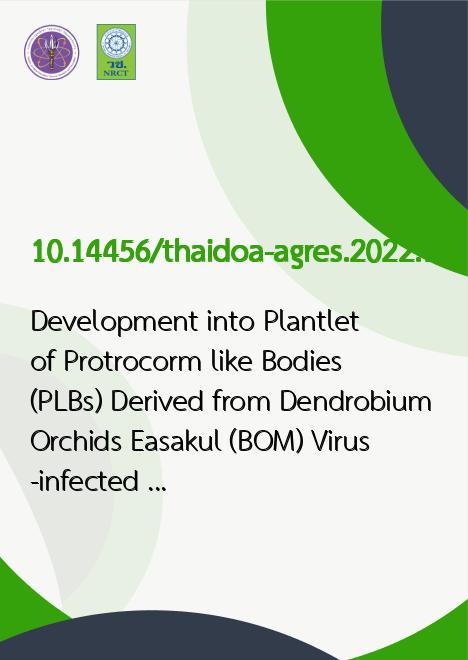
|
Development into Plantlet of Protrocorm like Bodies (PLBs) Derived from Dendrobium Orchids Easakul (BOM) Virus-infected with Cymbidium Mosaic Virus (CymMV) and Virus-free |
|---|---|
| รหัสดีโอไอ | |
| Creator | Sitthisak Saepaisal |
| Title | Development into Plantlet of Protrocorm like Bodies (PLBs) Derived from Dendrobium Orchids Easakul (BOM) Virus-infected with Cymbidium Mosaic Virus (CymMV) and Virus-free |
| Contributor | Surapee Kiratiyaangul, Jade Meyanyieam, Duangporn Boonchai |
| Publisher | Department of Agriculture |
| Publication Year | 2565 |
| Journal Title | Thai Agricultural Research Journal |
| Journal Vol. | 40 |
| Journal No. | 2 |
| Page no. | 165-176 |
| Keyword | orchid, free-virus, CymMV, protrocorm like bodies (PLBs) |
| URL Website | https://at.doa.go.th/journal |
| Website title | Thai Agricultural Research Journal |
| ISSN | 0125-8389 |
| Abstract | Orchid genus Dendrobium Sonia Earsakul (BOM) has a high rate of infection with the Cymbidium mosaic virus (CymMV) due to the use of propagating techniques of dividing or cutting stem from the virus-infected mother plant. This study investigated effects of CymMV on the growth and development of BOM orchids, by taking the bud fragments of the virus-free and virus-infected orchid and induced the generation of protocorm-like bodies (PLBs) and compared on the formation and the number of PLBs. Results showed that, at 45 days the number of PLBs from virus-free orchids was 2 times over those from virus-infected orchids, and at 65 days the number of PLBs from virus-free orchids increased by 2.5 times more than those from virus-infected orchids and was statistically significant different. When PLBs were cultured on a modified Vacin and Went (VW) medium to induce PLBs to plantlets, virus-free PLBsdevelopedintolargeplantlets threetimes faster thanthosefrom virus-infected which were also statistically significant different. It was also found that the fresh weight and dry weight of virus-free plants were significantly higher than those infected with the virus. Both groups of orchid plantlets were further cultured in modified VW medium for induction intoyoungplants (transitional stage) tocomparegrowthrates. It was foundthatafter120days of culturing, the virus-free plantlets grew 20 percent faster than the virus-infected plantlets, and the young virus-free plants had the height and the mean of the number of roots more than 2 times to the virus-infected plants. When the plantlets were taken out of the culture bottle and cultured continuously for 10 months to compare the growth and development of the inflorescences. It was found that the small and medium-sized virus-free plants had larger leaf sizes (leaf width andlength) than virus-infectedplants which was statistically significant different. At 6 -10 months of age, virus-free plants were larger andhada35 % faster flowering rate than virus-infected plants. |